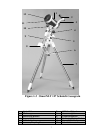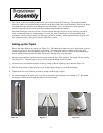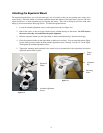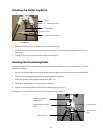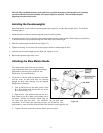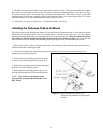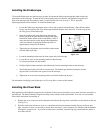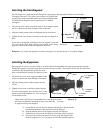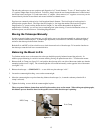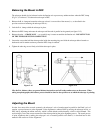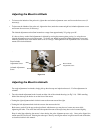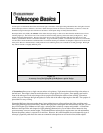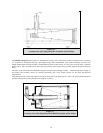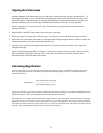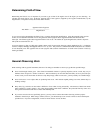
The refracting telescopes can use eyepieces and diagonals of a 2” barrel diameter. To use a 2” barrel eyepiece, the 1
” eyepiece adapter must first be removed. To do this, simply loosen the two chrome thumbscrews located around
e focuser barrel (see figure 2-12) and remove the 1 ¼” adapter. Once removed, a 2” eyepiece or accessory can be
d secured with the two thumb screws.
t
nification.”
¼
th
inserted directly into the focuser barrel an
Eyepieces are commonly referred to by focal length and barrel diameter. The focal length of each eyepiece is
printed on the eyepiece barrel. The longer the focal length (i.e., the larger the number) the lower the eyepiece
magnification (i.e., power) and the shorter the focal le
magnification. Generally, you will use low-to-modera
ngth (i.e., the smaller the number) the higher the
e power when viewing. For more information on how to
determine power, see the section on “Calculating Mag
M
M
o
o
v
v
i
i
n
n
g
g
t
t
h
h
e
e
T
T
e
e
l
l
e
e
s
s
c
c
o
o
p
p
e
e
M
M
a
a
n
n
u
u
a
a
l
l
l
l
y
y
ill need to move your telescope manually at various portions of
observe different objects. To make rough adjustments, loosen the R.A. and DEC clutch knobs slightly
h down each axis of the telescope. To loosen the clutches on
.
In order to properly balance your telescope, you w
the sky to
and move the telescope in the desired direction.
Both the R.A. and DEC axis have lock levers to clutc
the telescope, rotate the lock levers counterclockwise
B
B
a
a
l
l
a
a
n
n
c
c
i
i
n
n
g
g
t
t
h
h
e
e
M
M
o
o
u
u
n
n
t
t
i
i
n
n
R
R
.
.
A
A
.
.
To e nced around the polar axis. In
addi accurate tracking if using an optional motor drive. To balance the mount:
1. Release the R.A unt (make sure that the
mounting bracket sc on the opposite side of the mount
(see figure 2-12
2. Release the tele
3. Loosen the counterweight locking screw on the counterweight.
4.
5.
hese are general balance instructions and will reduce undue stress on the mount. When taking astrophotographs,
Figure 2-13
liminate undue stress on the mount, the telescope should be properly bala
tion, proper balancing is crucial for
. Clamp (see figure 2-13) and position the telescope off to one side of the mo
rew is tight). The counterweight bar will extend horizontally
).
scope — GRADUALLY — to see which way the telescope “rolls.”
Move the counterweights to a point where they balance the telescope (i.e., it remains stationary when the R.A.
clamp is released).
Tighten the locking screw to hold the counterweights in place.
T
this balance process should be done for the specific area at which the telescope is pointing.
DEC Clamp
R.A. Clamp
15



